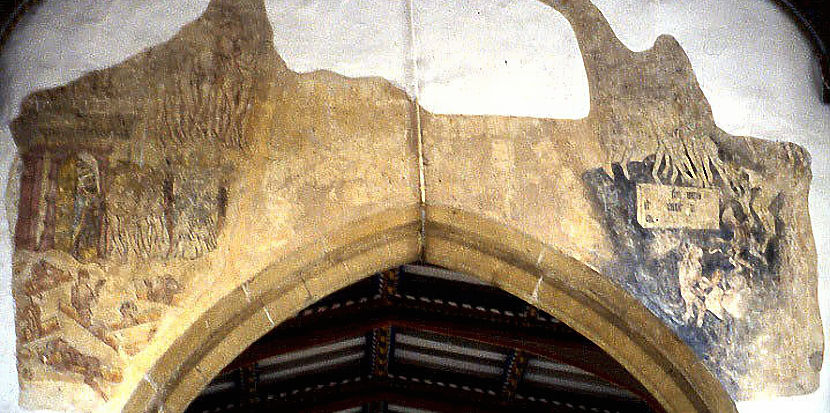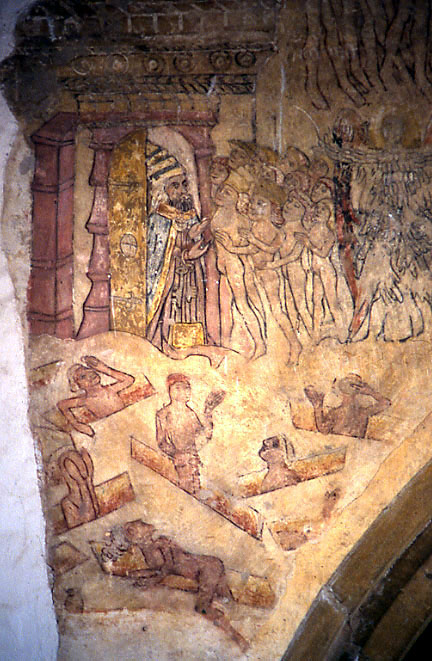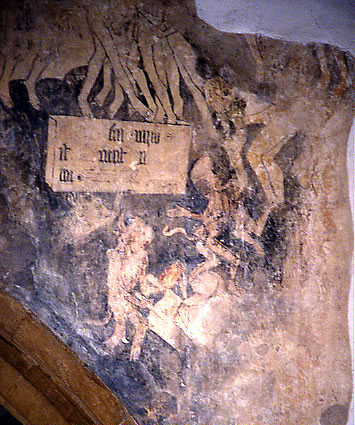Bacton, Suffolk (†St Edmundsbury & Ipswich)C.15
Doom


The central part of this 15th century Doom has gone completely, but there are some very interesting details in the side sections, pictured in detail below. At the left, the saved are welcomed by St Peter, a splendid figure in the papal tiara and gold-bordered robes, his keys hanging from his wrist There may be a pope or two among the awestruck naked group standing in line to the right, along with a possible cardinal and king, several men with tonsures and perhaps even some scholars in academic caps. Below, other figures rise from their graves.
Although the painter here was no great master, he has worked hard at suggesting various attitudes of amazement, and the semi-recumbent figure (perhaps another pope, with tiara) at the bottom of the scene, pictured clambering over the edge of a tomb with head turned to look upward, is drawn with some elegance.
At the top right of this side of the painting another group of figures with particularly long slender legs like all those here, has probably just arrived at the gates of Heaven. They may be about to encounter St Michael, the Weigher of Souls, who is perhaps the obscure but heavily feathered figure standing just below (extreme right).

But the most interesting aspect of all is the painted architecture here. St Peter is framed by an elaborate doorway in a gloriously eclectic mixture of architectural styles. Two pillars, at least one of them with odd horizontal fluting and painted in purple-red, have a broader square pillar to the left and support a classical-style entablature decorated with a horizontal row of chevrons and above that, several circular motifs. It all looks very Italianate, and it certainly suggests a degree of acquaintance with Continental architectural styles on the part of the painter.
At the right, things in Hell are chaotic, as usual. A group of people at the top are possibly being prodded into Hell by a figure at the left, reduced now to its lower legs, and below the feet of this group is a rectangular panel or cartouche with an inscription. Unreadable now, it is probably God’s declaration ‘Ite, maledicti…’ attached to several of the Dooms in these pages, or some variant of it.¹
Around and below this, figures fall into Hell and at the bottom, damaged now but detectable, is a devil (with a tail) pushing a wheelbarrow loaded with at least one and probably more figures. I think there is another prancing devil, possibly blowing a horn, above the wheelbarrow, but these small details are hard to see. This is, evidently, someone literally going to Hell in a handcart, a detail found also at nearby Yaxley, and, newly on the site, at Chesterton in Cambridgeshire.
Similar details, suggesting reference to proverbs or sayings, crop up across the spectrum of later medieval art – a wheelbarrow, carrying an unhappy-looking jester standing in a wicker basket appears in a contemporary Burgundian manuscript². The man pushing it is not visibly devilish, but like the Bacton detail, the illustration may be a comment, more meaningful then than now, on the fate of those who pursue folly.
¹ Munro Cautley’s (Suffolk Churches, p.219) sugestion that this is a superimposed “Elizabethan black letter inscription” seems to me highly unlikely.
² The Black Hours of Charles the Rash, Duke of Burgundy, f.33, reproduced in John Harthan, Books of Hours and their owners, Thames & Hudson, 1978, p.108. The text on the page is the opening of John’s Gospel – ‘In principio erat verbum…’